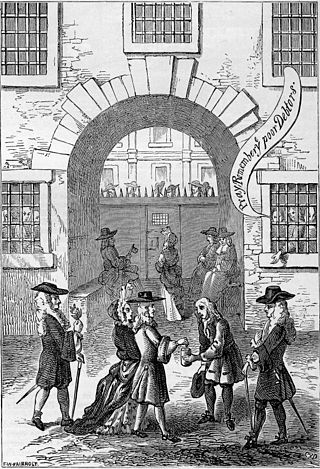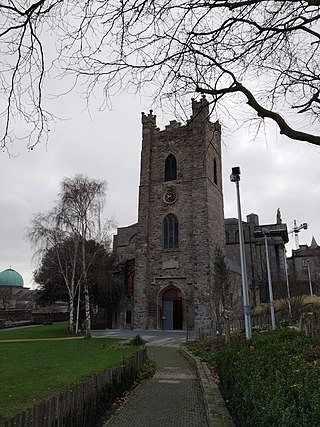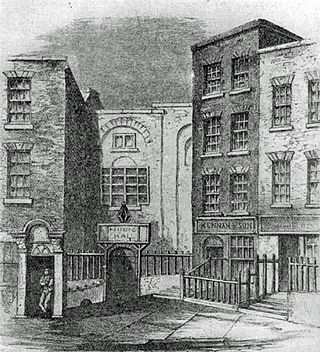
Newgate Prison was a prison at the corner of Newgate Street and Old Bailey Street just inside the City of London, England, originally at the site of Newgate, a gate in the Roman London Wall. Built in the 12th century and demolished in 1904, the prison was extended and rebuilt many times, and remained in use for over 700 years, from 1188 to 1902.
A sheriff is a government official, with varying duties, existing in some countries with historical ties to England where the office originated. There is an analogous, although independently developed, office in Iceland that is commonly translated to English as sherif.

York Castle is a fortified complex in the city of York, England. It consists of a sequence of castles, prisons, law courts and other buildings, which were built over the last nine centuries on the south side of the River Foss. The now ruined keep of the medieval Norman castle is commonly referred to as Clifford's Tower. Built originally on the orders of William I to dominate the former Viking city of Jórvík, the castle suffered a tumultuous early history before developing into a major fortification with extensive water defences. After a major explosion in 1684 rendered the remaining military defences uninhabitable, York Castle continued to be used as a gaol and prison until 1929.

A dungeon is a room or cell in which prisoners are held, especially underground. Dungeons are generally associated with medieval castles, though their association with torture probably belongs more to the Renaissance period. An oubliette or bottle dungeon is a basement room which is accessible only from a hatch or hole in a high ceiling. Victims in oubliettes were often left to starve and dehydrate to death, making the practice akin to—and some say an actual variety of—immurement.

Fleet Prison was a notorious London prison by the side of the River Fleet. The prison was built in 1197, was rebuilt several times, and was in use until 1844. It was demolished in 1846.

Jack Sheppard, or "Honest Jack", was a notorious English thief and prison escapee of early 18th-century London.

Oxford Castle is a large, partly ruined medieval castle on the western side of central Oxford in Oxfordshire, England. Most of the original moated, wooden motte and bailey castle was replaced in stone in the late 12th or early 13th century and the castle played an important role in the conflict of the Anarchy. In the 14th century the military value of the castle diminished and the site became used primarily for county administration and as a prison. The surviving rectangular St George's Tower is now believed to pre-date the remainder of the castle and be a watch tower associated with the original Saxon west gate of the city.

Margaret Ball (1515–1584) was a prominent member of 16th-century Irish society, who, despite being the widow of a Lord Mayor of Dublin, was arrested for her adherence to the Catholic faith and died of deprivation in the dungeons of Dublin Castle. She was declared a martyr for the faith by the Catholic Church and beatified in 1992, one of a group of 17 Irish Catholic Martyrs.

Newgate Prison was a place of detention in Dublin, Ireland. It was initially located at Cornmarket, near Christ Church Cathedral, on the south side of the Liffey and was originally one of the city gates before being moved to a new purpose built prison on Green Street on the North side of the city in 1781. The prison finally closed in 1863 while the building was demolished in 1893. The site today contains Saint Michan's Park while the remains of the prison's boundary walls still form part of the boundary of the park.

Poultry Compter was a small prison that stood at Poultry, part of Cheapside in the City of London. The compter was used to lock up minor criminals and prisoners convicted under civil law and was run by the City's Sheriff. It operated from the 16th century until 1815. It was pulled down in 1817 and replaced with a chapel.

The Marshalsea (1373–1842) was a notorious prison in Southwark, just south of the River Thames. Although it housed a variety of prisoners—including men accused of crimes at sea and political figures charged with sedition—it became known, in particular, for its incarceration of the poorest of London's debtors. Over half the population of England's prisoners in the 18th century were in jail because of debt.

Green Street Courthouse is a courthouse between Green Street and Halston Street in the Smithfield area of Dublin, Ireland. It was the site of many widely discussed criminal trials from 1797 until 2010, when the Criminal Courts of Justice building opened.

St Audoen's Church is the church of the parish of Saint Audoen in the Church of Ireland, located south of the River Liffey at Cornmarket in Dublin, Ireland. This was close to the centre of the medieval city. The parish is in the Diocese of Dublin and Glendalough. St Audoen's is the oldest parish church in Dublin and is still used as such. There is a Roman Catholic church of the same name adjacent to it.

Prisons in Ireland are one of the main forms of punishment, rehabilitation, or both for the commission of an indictable offense and other offenses.
Sir Vere Hunt, 1st Baronet of Currah was an Irish politician, landowner and businessman. He is chiefly remembered for founding the village of New Birmingham in County Tipperary, for his ill-advised purchase of the island of Lundy, and for his entertaining diary. He was a colourful character, who was noted for his heavy drinking and gambling, but also for his intellectual interests, and his stern criticism of his own class.
The City Marshalsea was a debtor's prison in Dublin, Ireland. Debtors were imprisoned there by order of the Court of Conscience and Lord Mayor's Court of the county of the city of Dublin. The maximum debt was £10 in the Lord Mayor's Court, and 40s. (£2) in the Court of Conscience.

The Debtors' Prison Dublin is a historic building in Dublin’s north inner city, between Halston Street and Green Street. While it is listed on Dublin City Council's Record of Protected Structures, it was also included on the list of 'Top 10 Most-at-Risk' buildings, published by An Taisce in 2021. It is adjacent to Green Street Courthouse.

The Black Dog of Newgate is a legend concerning the haunting of the former Newgate Prison of London, which was located next to the Old Bailey, close to St. Pauls Cathedral, in London, England.

The Four Courts Marshalsea was a prison in Dublin, Ireland until 1874. The keeper of the prison was the Marshal of the Four Courts, a role filled after 1546 by the Constable of Dublin Castle.

Neale's Musick Hall, also known as Mr. Neal's New Musick Hall, Mr. Neale's Great Room, Neal's Musick Room, the Great Musick Hall, Neale's Great Musick Hall or the Fishamble Street Music Hall was a purpose-built music hall that existed on Fishamble Street in Dublin city centre. It was built using subscriptions from a charitable organisation named 'The Charitable and Musical Society', and operated from 1741 until the mid-19th century. William Neale, a local musical instrument-maker and music publisher, was the secretary/treasurer of the society during the conception and construction phase of the project. The building is most notable for the premiere of Handel's Messiah which took place within it on the afternoon of 13 April 1742.

















